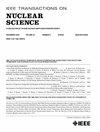使用不同的反应堆物理模型和CADIS加速MCNP产生1 MeV硅等效通量中子损伤
IF 1.9
3区 工程技术
Q3 ENGINEERING, ELECTRICAL & ELECTRONIC
引用次数: 0
摘要
在这里,我们开发和探索混合模拟技术,以加快辐射硬度保证测试工作的实验设计的测试前分析。具体来说,我们将重点放在中子位移损伤(NDD)测试上,该测试由美国试验与材料协会(ASTM)标准规程E722管理,该规范以1 MeV硅当量来表征测试设施中子源。在此过程中,我们开发并比较了使用评估核数据文件(ENDF)库为任何材料创建损伤指标的方法。此外,还建立了简单的单胞模型,并进行了验证,以提供与犹他大学训练、研究、同位素、一般原子(TRIGA)核反应堆全堆芯模型相当的1 MeV硅当量通量的合理估计。通过混叠同一模型的确定性解,将全核临界特征值计算转化为固定源问题。该方法实现了模型的加速和一致伴随驱动重要抽样(CADIS)方差减少技术的应用,使蒙特卡罗计算速度达到10 - 100倍,在样本目标区域具有出色的统计数据,为UUTR在NDD测试的高效参数研究中的应用铺平了道路。本文章由计算机程序翻译,如有差异,请以英文原文为准。
Use of Different Reactor Physics Models and CADIS Accelerated MCNP to Yield a 1 MeV Silicon Equivalent Flux for Neutron Damage
Here, we develop and explore hybrid simulation techniques to expedite pre-test analysis of experimental designs for radiation hardness assurance testing efforts. Specifically, we focus on neutron displacement damage (NDD) testing, governed by American Society of Testing and Materials (ASTM) Standard Practice E722, which characterizes test facility neutron sources in terms of 1 MeV silicon equivalents. In doing so, we develop and compare a methodology for creating damage metrics for any materials using Evaluated Nuclear Data File (ENDF) libraries. Moreover, simple unit cell models were created and demonstrated to provide reasonable estimates for 1 MeV silicon equivalents flux comparable to the full core model of the training, research, isotopes, general atomics (TRIGA) nuclear reactor at the University of Utah. Criticality eigenvalue calculations in the full core were converted to fixed source problems by aliasing a deterministic solution of the same model. This approach the enabled acceleration of models and the application of consistent adjoint driven importance sampling (CADIS) variance reduction techniques, enabling Monte Carlo computational speedups of 10–100-fold with excellent statistics in the sample target area, paving the way for the application of the UUTR in highly efficient parameter studies for NDD testing.
求助全文
通过发布文献求助,成功后即可免费获取论文全文。
去求助
来源期刊

IEEE Transactions on Nuclear Science
工程技术-工程:电子与电气
CiteScore
3.70
自引率
27.80%
发文量
314
审稿时长
6.2 months
期刊介绍:
The IEEE Transactions on Nuclear Science is a publication of the IEEE Nuclear and Plasma Sciences Society. It is viewed as the primary source of technical information in many of the areas it covers. As judged by JCR impact factor, TNS consistently ranks in the top five journals in the category of Nuclear Science & Technology. It has one of the higher immediacy indices, indicating that the information it publishes is viewed as timely, and has a relatively long citation half-life, indicating that the published information also is viewed as valuable for a number of years.
The IEEE Transactions on Nuclear Science is published bimonthly. Its scope includes all aspects of the theory and application of nuclear science and engineering. It focuses on instrumentation for the detection and measurement of ionizing radiation; particle accelerators and their controls; nuclear medicine and its application; effects of radiation on materials, components, and systems; reactor instrumentation and controls; and measurement of radiation in space.
 求助内容:
求助内容: 应助结果提醒方式:
应助结果提醒方式:


